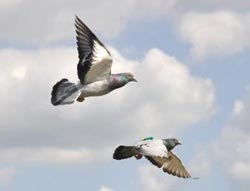Hedges and edges help pigeons learn their way around

These are homing pigeons in flight, equipped with GPS trackers. The study found that homing pigeons' ability to remember routes depends on the complexity of the landscape below<br><br>Credit: Zsuzsa Ákos<br>
A study has found that homing pigeons' ability to remember routes depends on the complexity of the landscape below, with hedges and boundaries between urban and rural areas providing ideal landmarks for navigation.
Researchers from Oxford University, the Zoological Society of London and Uppsala University, Sweden released 31 pigeons from four sites around Oxford for an average of 20 flights each. The study, published in Biology Letters this week, found that pigeons were better able to memorise flight paths when the landscape below was of a certain visual complexity, such as rural areas with hedges or copses.
'We discovered that pigeons' ability to memorise routes is highly influenced by the visual properties of the landscape in a 250 metre radius below them,' said lead author Dr Richard Mann of Uppsala University Sweden, formerly of Oxford University where he conducted the study. 'Looking at how quickly they memorise different routes, we see that that visual landmarks play a key role. Pigeons have a harder time remembering routes when the landscape is too bland like a field or too busy like a forest or dense urban area. The sweet spot is somewhere in between; relatively open areas with hedges, trees or buildings dotted about. Boundaries between rural and urban areas are also good.'
Understanding how pigeons learn to find their way is important because they are able to navigate exceptionally well despite having small brains. Whatever method they use to remember routes must therefore make highly efficient use of their limited mental processing power.
'There may be certain rules that free-flying birds use to structure information that enable them to map the environment using their limited brain power,' said co-author Tim Guilford, Professor of Animal Behaviour at Oxford University's Department of Zoology. 'Fundamentally understanding how they do this will tell us more about their abilities and limitations, and could reveal methods that robots with limited processing power might use to navigate.'
Knowing the landscape features that pigeons use to navigate could also help researchers to predict the flight patterns of any birds that are diurnal; active during the day. Identifying the likely flight paths of birds could be of use to conservationists, birdwatchers and town planners.
'Homing pigeons provide a reliable model for studying navigation and there's no reason to believe that other diurnal birds won't use similar methods,' said Professor Guilford. 'We mainly use pigeons for studies like this because we can be confident that they will bring back the GPS devices with the data. With wild birds, there is a real risk that we won't get the equipment and data back, but fundamentally we expect them to use similar navigational methods.'
The study was funded by the Engineering and Physical Sciences Research Council, European Research Council, the Royal Society and the Biotechnology and Biological Sciences Research Council.
Media Contact
More Information:
http://www.ox.ac.ukAll latest news from the category: Life Sciences and Chemistry
Articles and reports from the Life Sciences and chemistry area deal with applied and basic research into modern biology, chemistry and human medicine.
Valuable information can be found on a range of life sciences fields including bacteriology, biochemistry, bionics, bioinformatics, biophysics, biotechnology, genetics, geobotany, human biology, marine biology, microbiology, molecular biology, cellular biology, zoology, bioinorganic chemistry, microchemistry and environmental chemistry.
Newest articles

Optimising inventory management
Crateflow enables accurate AI-based demand forecasts. A key challenge for companies is to control overstock and understock while developing a supply chain that is resilient to disruptions. To address this,…

Cause of rare congenital lung malformations
Gene mutations in the RAS-MAPK signaling pathway disrupt lung development in the womb. Most rare diseases are congenital – including CPAM (congenital pulmonary airway malformations). These are airway malformations of…

“Nanostitches” enable lighter and tougher composite materials
In research that may lead to next-generation airplanes and spacecraft, MIT engineers used carbon nanotubes to prevent cracking in multilayered composites. To save on fuel and reduce aircraft emissions, engineers…





















